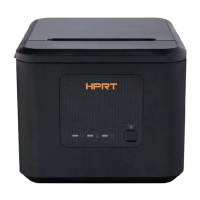Define
the
NV bit image specified by n.
n specifies the number of the defined NV bit image.
xL, xH specifies (xL + xH × 256) × 8 dots in the horizontal direction for the NV
bit image you are defining.
yL, yH specifies (yL + yH × 256) × 8 dots in the vertical direction for the NV bit
image you are defining.
Frequent write command executions may damage the NV memory.
Therefore, it is recommended to write the NV memory 10 times or less a day.
This command cancels all NV bit images that have already been defined by
this command. The printer cannot redefine only one of several data
definitions previously defined. In this case, all data needs to be sent again.
During processing of this command, the printer is BUSY when writing data to
the user NV memory and stops receiving data. Therefore it is prohibited to
transmit the data, including real-time commands, during the execution of this
command.
NV bit image is a bit image defined in non-volatile memory by FS q and
printed by FS p.
In standard mode, this command is effective only when processed at the
beginning of the line.
This command is effective when 7 bytes <FS yH> of the command are
processed normally.
When the amount of data exceeds the capacity left in the range defined by xL,
xH, yL, yH, the printer processes xL, xH, yL, yH out of the defined range.
In the first group of NV bit images, when any of the parameters xL, xH, yL, yH
is out of the definition range, this command is disabled.
In groups of NV bit images other than the first one, when the printer
encounters xL, xH, yL, yH out of the defined range, it stops processing this
command and starts writing into the NV images. At this time, NV bit images
that haven’t been defined are disabled (undefined), but any NV bit images
before that
are
enabled.
The d indicates the definition data. In data (d) a 1 bit specifies a dot to be
printed and a 0 bit specifies a dot not to be printed.
This command defines n as the number of a NV bit image. Numbers rise
in

